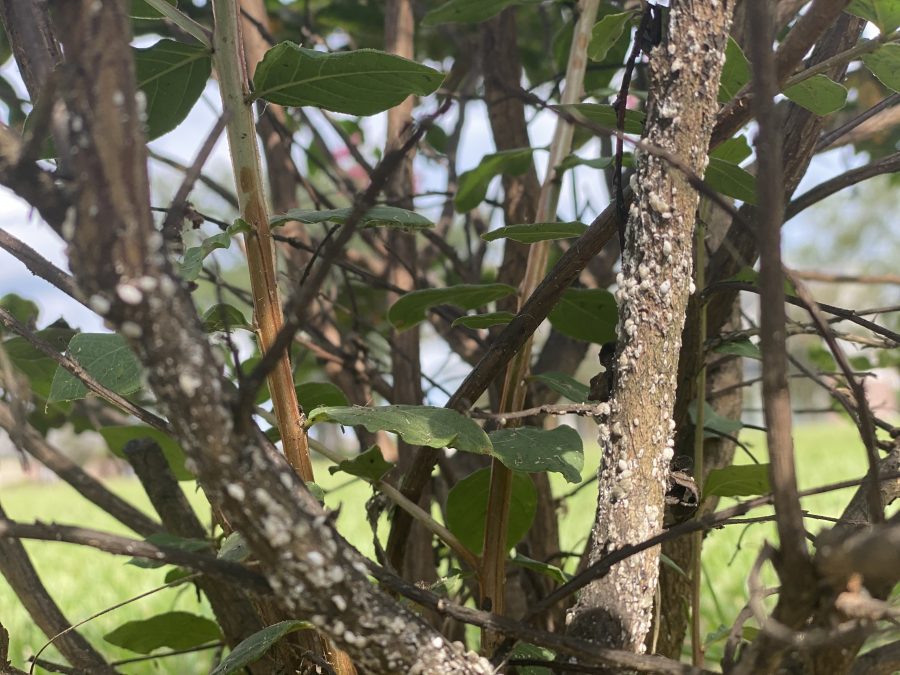
Graves Introduces Bipartisan Legislation to Stop Flood Insurance Price Surges
April 4, 2022
Dine to donate to BCCM at La Casa Del Sol today
April 4, 2022By Yan Chen and Rodrigo Diaz
Crape myrtles are a beloved tree in the Southeast. Before the recent introduction of a serious scale insect, the crapemyrtle bark scale (Acanthococcus lagerstroemiae), they required minimal care. A heavy infestation of the crapemyrtle bark scale may cause dieback, stunted growth, few or no blooms, or death of young trees. The first sign of an infestation is often the black sooty mold caused by the colonization of several fungi on honeydew secreted by the scale. Colonies of white or gray feltlike bumps on branches that bleed pink “blood” when crushed can confirm an infestation.
Since its first report in Bossier City, Louisiana, in 2014, this pest has spread to almost every part of the state. Questions from landscape managers and homeowners about the pest have become one of the top pest-related inquiries received by LSU AgCenter extension personnel. Soon after its first report, AgCenter scientists began working on the biology and management of this pest. In 2017, with the support of a major U.S. Department of Agriculture grant, a research team from across the southeast region collaborated to fight this pest.
Crawler Population Monitoring and Early Spring Treatments
The first instar nymph of the crapemyrtle bark scale is mobile and is called a crawler. In this life stage they move around to find a suitable spot to settle and are responsible for distribution of new infestations. This life stage is most vulnerable to insecticides. Once crawlers develop their waxy coating and become fixed in place, they are particularly resistant to contact pesticides. Therefore, being able to better predict the emergence of the crawler stage is critical for effective management and prevention of new infestations. Based on multiple years of monitoring crawler activities, it was found that in much of Louisiana the first crawlers emerge in mid-May, and then emergence in mid-October in New Orleans and areas south.
These peak crawler emergence periods provide the best treatment windows for using low-impact natural products or selective pesticides that require good contact with the crawlers to be effective. Applying insect growth regulators, such as pyriproxyfen, during the crawler peaks can reduce crawler density by 85% to 100% for up to four months after one application. Applying horticultural oil or other petroleum-based products can provide up to 50% control, which is still desirable when used in combination with other natural products.
Risks with Neonicotinoids
Data from several field trials indicate that systemic insecticides, particularly neonicotinoids that contain imidacloprid, clothianidin, dinotefuran and thiamethoxam, are the most effective control options against crapemyrtle bark scale, especially when applied to the soil. However, this class of pesticides poses potential risks to beneficial and nontarget insects. Crape myrtles do not have nectar, but they serve an abundant amount of pollen to bees and beneficial insects throughout the summer. A study by Auburn University revealed many pollinators, including honeybees, bumble bees, native bees and several flies, wasps and other insects, visited crape myrtle trees in suburban locations. There is also a concern over the high cost of these neonicotinoid treatments. It was also recommended to treat surrounding crape myrtles, even if they are not apparently infested. This can pose a greater risk to beneficial insects and pollinators.
A pollen residual study was conducted to evaluate the risk of translocation of imidacloprid and dinotefuran into pollen following a soil application at different timings. Both insecticides were applied at label-recommended rates. Pollen samples were collected and analyzed for residuals of imidacloprid (and metabolites) and dinotefuran. Results showed that regardless of application timing, significant concentration levels of both active ingredients were found in crape myrtle pollen (Figure 1). In general, dinotefuran was found in significantly higher concentrations than imidacloprid from the same application timing. Treatment concentrations were translated into the estimated mean oral amount of each active ingredient when consumed by honeybee workers based on their average daily consumption amount (Figure 2). All the applications before blooming exceeded the chronic oral lowest observable adverse effect concentration for adult honeybees. In addition, there might be contact exposure to contaminated pollen, which poses direct risk to bees visiting neonicotinoid-treated trees.
Entomological Fungi: A Natural Enemy
Because the crapemyrtle bark scale is an exotic pest, it does not have many natural enemies in the U.S. Five species of lady beetles have been found feeding on this scale. Because more specific biological control agents, such as parasitic wasps, are still being studied, it is important to conserve the natural enemies in the landscapes. Fungal or bacterial biopesticides are developed from fungi or bacteria with shown efficacies against insect pests but with relatively lower impact on other organisms. A series of efficacy trials was conducted to evaluate four such biopesticides. Products were applied as trunk sprays to trees infested with crapemyrtle bark scale during winter, spring and fall 2019. BioCeres (Beauveria bassiana strain ANT-03) significantly increased mortality of the crapemyrtle bark scale only in the winter trial, and BotaniGard (Beauveria bassiana strain GHA) was more effective in a trial conducted in the fall. However, all products failed to be effective in the late spring trial of which ambient temperatures were significantly higher than other trials.
These biopesticides were assessed in laboratory conditions by dipping the insects in a biopesticide mixture and observing their survival. BotaniGard significantly reduced the survival of larvae and adults of beneficial lady beetles, and BioCeres reduced the longevity of both lady beetles by 40%. These results suggest that application of these biopesticides still pose considerable risk to beneficial lady beetles known to attack crapemyrtle bark scale.
This is not a short-stay pest, and it takes time to have what is needed to save crape myrtles. With new research findings, there is a better understanding of this pest and its interactions with other players in this battle.







